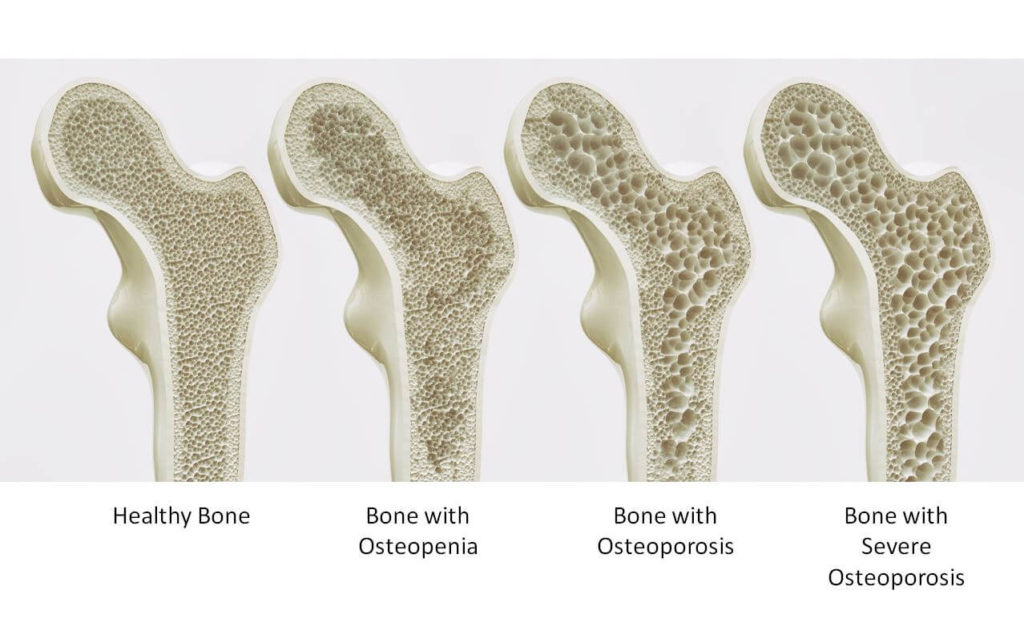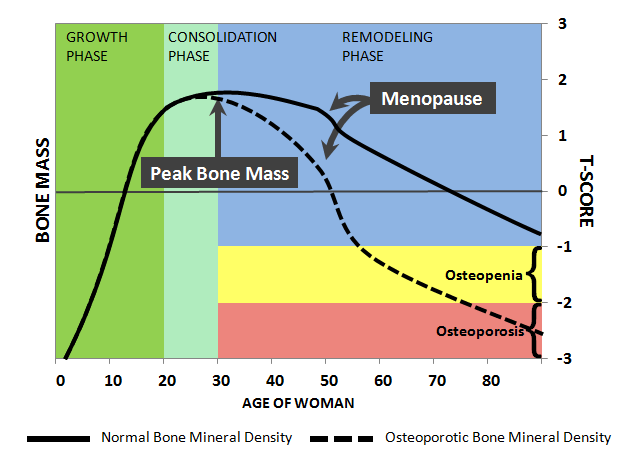Your body needs a strong foundation, and where better to start than with your bones? In your mid- to late-twenties, the bones in your body start decreasing in mass and density. This puts older adults at risk for a common bone disease called osteoporosis. There are ingredients your bones need for good health that many people simply don’t get enough of.
Imagine baking a cake and not putting in enough eggs and oil – the cake wouldn’t be nearly as moist as you like and would tend to crumble. Do you know which ingredients can help to keep your bones strong? Are you getting enough of them?
What is Osteoporosis?
Osteoporosis is a serious bone condition in which the bones lose strength and density at a rate higher than the regular aging process. Large holes develop in the bone – especially in the spongy inner layer of the bone. This thinning process of the inner bone means that the strength of the bone is predominantly preserved by its hard-outer shell.

The best way to measure osteoporosis is to measure a person’s bone mineral density (BMD), which takes just a few minutes in a pharmacy – or a more extensive test can be done at a clinic or medical center. This BMD measurement is then compared to the BMD of a healthy adult. If someone has a low BMD (a T-score less than -1), it is likely that they have osteoporosis; or the less serious counterpart to the disease, osteopenia. See the chart below:

The main concern for people who have osteoporosis is the increased risk of fracture. Simple falls can break bones – especially because the most common sites for osteoporotic bones are the hip and wrist, which many people land on when they fall. A study published in the Journal of Bone and Mineral Research revealed that approximately 45% of women over fifty are affected by osteoporotic sites in their hip, spine, and forearm. The study further explains that Caucasian women are particularly at risk. Those over fifty have a 40% chance of having a fracture in the hip, spine, or forearm in their remaining lifetime. These studies emphasize how common osteoporosis is.
What causes osteoporosis?
To understand the causes of osteoporosis, it is important to understand normal bone growth. Your body is a finely-tuned instrument – if one string is out of tune, the music does not sound right. Two essential minerals for normal bone formation are calcium and phosphorous. If these levels are too low in your bloodstream (the note is flat), your body tries to “tune” or balance the levels of these minerals. It does so by gradually breaking down the inner bone tissue (called resorption) which contains these various minerals, and releasing them into the bloodstream. After the problem with low calcium and phosphorous in the bloodstream is corrected (and the instrument is tuned), the bone can be reformed. Initially, magnesium is used to “activate” vitamin D. This activated form of vitamin D helps absorb dietary calcium and phosphorous. The calcium and phosphorous finish the cycle by helping to build strong, healthy bone.
Our skeleton is replacing itself almost every 10 years. If this process is interrupted, the bones cannot be rebuilt after the calcium is released into the bloodstream – permanently weakening them. Thus, it is important to have sufficient amounts of calcium, phosphorous, vitamin D, vitamin K, and magnesium in your diet at all times. The lack of specific hormones (estrogen for women or testosterone for men), thyroid problems, and even certain medications (such as the overuse of corticosteroids) can contribute to osteoporosis. The lack of estrogen when a woman ages, particularly in menopause, brings about a more rapid onset of osteoporosis if not careful.
Your skeleton’s crew
Calcium
It is well-known that calcium is important for bone health – this is why we are encouraged to drink milk. Calcium makes up the crystal structure of the bones. Bone mineral is primarily composed of calcium phosphate, which forms small, rigid crystals. These crystals help the bones to be strong and hard.
About 99% of the body’s calcium is stored in the bones; the other 1% is in the bloodstream. The calcium in the bloodstream regulates important bodily functions such as muscle contractions and nerve impulse conduction. The amount of calcium in the bloodstream must be controlled precisely. If it dips too low, the body responds by “stealing” and releasing it from the bones.
Phosphorous
A lesser-known component of bone is phosphorous. It is the most important mineral in bone other than calcium and is the second most plentiful mineral in your body behind calcium. Half of the mass of bone mineral is phosphorous. This is because phosphorous is a main component in the calcium phosphate crystals that make up bone. When bone calcium is released due to low calcium levels in the blood, phosphorous is also released into the bloodstream.
Vitamin D
Vitamin D and calcium are closely linked in bone health because vitamin D helps dietary calcium absorb through the intestinal lining. A study published in the Journal of Clinical Endocrinology & Metabolism explains that vitamin D and calcium consumed together leads to more calcium being absorbed than consuming calcium alone. This is why nearly almost all of the US milk supply, the key source of dietary calcium, is fortified with Vitamin D. However, vitamin D must be converted to its active form, calcitriol, before it is able to work effectively.
Vitamin D is produced in the body through exposure to sunlight. UV radiation on uncovered skin allows the body to create its own D3. People in northern latitudes have been found to be chronically deficient in vitamin D. Complete cloud cover reduces UV energy by 50%, shade by 60%, and glass by 100%. Indoor sunshine does not provide any benefit for creation of vitamin D. Sunscreens with a SPF factor of 8 or more also will block vitamin D-producing UV rays. Researchers suggest 5-30 minutes of sun exposure between 10am and 3pm at least twice a week in southern latitudes to the face, arms, legs and back without sunscreen will usually lead to sufficient vitamin D creation. For more information about the health benefits of vitamin D, read my other article, “What You Need to Know about Vitamin D!”
Magnesium
Magnesium has two key functions in building strong bones. First, magnesium plays an important role in activating vitamin D. If magnesium isn’t present when processing vitamin D, it cannot be converted to calcitriol (the active form of vitamin D). The second function of magnesium is to increase bone strength. Over half of the body’s magnesium stores are found within bone mineral. Low levels of magnesium weakens the bone structure by depleting the internal crystal formation within the bone cells. Additionally, low levels of magnesium indirectly affects the secretion and activity of the important parathyroid glands that control calcium.
The parathyroid consists of four very small glands in the neck – located on the back of the thyroid gland. Each gland is about the size of a rice grain and is directly responsible for controlling blood and bone calcium levels. Think of this gland as a calcium thermostat which regulates calcium in a very tight range. The gland secretes a hormone called the parathyroid hormone (PTH), which increases the body’s ability to absorb calcium from the food we eat, helps the kidneys retain calcium (which would otherwise be eliminated via excretion), and releases calcium from bone to help increase calcium levels in the blood to normal. When blood levels normalize, or if they get a bit too high, the parathyroid gland will stop releasing PTH. Magnesium has a critical function in this process, and low levels of this important mineral can affect the normal function of this gland and ultimately lead to osteoporosis.
Vitamin K
Vitamin K is another important micronutrient that creates strong bones. There are two forms of vitamin K – vitamin K1 and K2 – and both are important in the formation of many of the collagen proteins that contribute to bone strength. A study published in Nutrition in Clinical Practice found that vitamin K increases BMD and decreases risk of fracture – both problems facing those with osteoporosis. Another study found that low dietary vitamin K intake has been associated with an increased risk specifically of hip fracture in men and women.
What is the best way to prevent osteoporosis?
To minimize the risk of osteoporosis, it is crucial to maintain a healthy lifestyle. It is important to avoid smoking and heavy drinking, as these can contribute to bone loss and increase the risk of bone fractures. Staying active is also important, since bone is living tissue that becomes stronger with the kind of exercise that forces you to work against gravity – so try to engage in activities like hiking, lifting weights, running, and jumping activities like volleyball and basketball. It is also helpful to maintain a healthy weight. While being overweight is known to cause strain on bones and joints, it can also reduce the amount of vitamin D that is released from the skin into the blood that is used to create calcitriol to form bones. Being underweight can create a higher risk for osteoporosis as it often associated with vitamin, mineral, and protein deficiencies that can cause a lower bone mineral density. Since many people struggle to consume all the appropriate nutrients, supplementation can help.
While all of these micronutrients are important for bone health, many are not found in sufficient quantities in the normal western diet. Calcium is the most important micronutrient to supplement with – and most people simply do not get enough of it. The National Institutes of Health recommend that adults consume 1,200 mg of calcium daily, but it was found that the average person in the US consumes about 75% of that amount. This may be due to the fact that some of the main sources of calcium are from dairy, and many people are lactose intolerant or simply don’t eat or drink enough milk products. A woman would have to eat 18 ounces of Greek yogurt, or four whole cups worth of kale, to reach the recommended daily amount of calcium. Since that may be difficult for some, high-quality supplements may be the easiest way to boost calcium in the body.
Although phosphorous is also one of the major players of bone health, taking phosphorous supplements is not recommended. The majority of Americans consume more phosphorous than is required and supplementation is not needed. Additionally, it has been suggested that excess phosphorous takes up calcium binding sites and interferes with calcium absorption.
Many people are also lacking in vitamin D. Either type of D vitamin – vitamin D2 or D3 – can be taken for benefit depending on whether a plant- or animal-based form is preferred. Vitamin D3, which is only found in animal-sourced foods, is more shelf-stable, potent and longer-acting than its counterpart D2 – which mainly comes from plant sources and mushrooms. It is recommended that adults take between 600 and 800 IUs of vitamin D3 daily. Very few foods in nature contain vitamin D. A convenient way to find dietary vitamin D is in fortified milk, however, one cup of milk usually only contains about 130 IU’s of vitamin D which is about 22% of the RDI. Such fortifications often utilize the less-potent D2 form, which is less expensive to synthetically manufacture. Note that those who suffer from lactose intolerance often have a vitamin D deficiency – just as they do with calcium. Foods which are naturally rich in vitamin D include salmon, herring, sardines, cod liver oil, canned tuna, mushrooms, and egg yolks. Vitamin D supplements are a convenient and good alternative to bring a sufficient amount of vitamin D into one’s diet.
Although severe magnesium deficiency is uncommon among adults in the US, studies show that many people consume less than the recommended dietary intake of 350 mg per day. For comparison, a person would have to consume 5 ounces of dry roasted almonds per day to achieve the recommended amount of magnesium. To ensure sufficient magnesium is available, consider supplementing with magnesium. Studies show that the diets of many fall short of the recommended daily intake of vitamin K. One study specifically found the inverse relationship of hip fracture with women who ate lettuce –a good dietary source of vitamin K. While vitamin K helps increase BMD, it also affects blood clotting, and can interfere with the effectiveness of some medications that are taken as blood thinners. For this reason, consult your health care practitioner before supplementing with vitamin K.
Which supplements can help protect my bones?
Those looking to boost their calcium should consider a high-quality supplement like Douglas Laboratories’ Calcium Microcrystalline Hydroxyapatite. Calcium microcrystalline hydroxyapatite (or MHCA, for short) is an extremely potent, absorbable form of calcium derived from pasture-fed, pesticide-free bovine that is tremendously helpful for maintaining bone health. But from this article, you know that calcium alone is insufficient without vitamin D. Those living in a northern state, or who simply don’t get outside much, should consider adding Thorne Research’s D-5,000 to ensure you are getting all the vitamin D3 you need to keep your bones strong.
If you think you get enough calcium and vitamin D, but could use more magnesium in your diet, a supplement like Pure Encapsulations’ Magnesium (citrate) is effective and well-absorbed by most people. If you feel you may be coming up short on all the vitamin and minerals discussed here, Metagenics’ Bone Builder with Magnesium is a comprehensive high quality supplement that includes vitamin D, calcium, phosphorous and magnesium. This is what I recommend to my patients.
Osteoporosis is a serious health concern that affects many people. It is important to stay healthy and make sure that you get enough calcium, vitamin D, and magnesium so that your bones function well. I hope this information is useful to you, and if you have any questions regarding the concepts discussed here or anything else, you can reach our customer service team at customerservice@oakwaynaturals.com or you can call them at 888-460-3091.
Until next time, stay healthy!
Yours in health,
Dr. Gregg Gittins












Comments are closed.